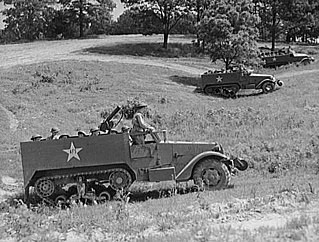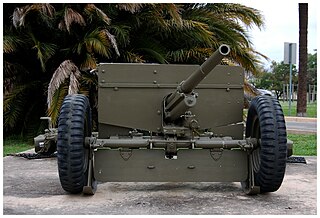
An anti-aircraft vehicle, also known as a self-propelled anti-aircraft gun (SPAAG) or self-propelled air defense system (SPAD), is a mobile vehicle with a dedicated anti-aircraft capability.

The Bofors 37 mm anti-tank gun was an anti-tank gun designed by Swedish manufacturer Bofors in the early 1930s originally for Swedish use. It was exported to several countries during the 1930s of which several bought licences to produce it themselves. The gun was used in several conflicts but most of its fame comes from its use in the Spanish Civil War and the Winter War where it was used very successfully against light tanks and armored cars among other targets. Beyond its use as an infantry gun it was also used as the main armament in several armored cars and tanks such as the Dutch M39 Pantserwagen and the Polish 7TP to name a few. As the armor of tanks was increased during World War II the gun very quickly became obsolete as an anti-tank gun but was still used effectively as an infantry support gun for the entirety of the war, and well into the Cold War. This was due to its high fire rate, great mobility and effective high explosive shells.

The Type 98 20 mm AAG tank was a Japanese self-propelled anti-aircraft gun using a twin Soki Type 2 20 mm anti-air gun. It used the chassis of the Type 98 Ke-Ni light tank.

The M3 half-track was an American armored personnel carrier half-track widely used by the Allies during World War II and in the Cold War. Derived from the M2 half-track car, the M3 was extensively produced, with about 15,000 standard M3s and more than 38,000 variant units manufactured.

The M8 light armored car is a 6×6 armored car produced by the Ford Motor Company during World War II. It was used from 1943 by United States and British forces in Europe and the Pacific until the end of the war. The vehicle was widely exported and as of 2006 still remained in service with some countries.

The 37 mm gun M3 is the first dedicated anti-tank gun fielded by United States forces in numbers. Introduced in 1940, it became the standard anti-tank gun of the U.S. infantry with its size enabling it to be pulled by a jeep. However, the continuing improvement of German tanks quickly rendered the 37 mm ineffective and, by 1943, it was being gradually replaced in the European and Mediterranean theaters by the more powerful British-developed 57 mm gun M1. In the Pacific, where the Japanese tank threat was less significant, the M3 remained in service until the end of the war, but some 57mm guns were issued.

The Landsverk Lynx was a series of Swedish 4x4 armoured cars developed by AB Landsverk just prior to World War II.

Pansarbandvagn 301, meaning roughly armoured tracked carrier vehicle 301, was a Swedish infantry fighting vehicle used by the Swedish Army. It was designed to carry a squad of 8 fully armed panzergrenadiers into battle and provide direct-fire support for them in combat. The panzergrenadiers could opt to either fight from inside the vehicle through hatches on the roof or dismount the vehicle and fight in its vicinity. The pbv 301 was armed with a Bofors 20 mm (0.8 in) L/70 aircraft gun taken from scrapped Saab 21 fighter aircraft, mounted in an oscillating housing above a rotating cupola. It was fed from 75 round belts stored inside the vehicle. Inside the vehicle were mountings for a variety of infantry weapons and munitions, such as an FN MAG and a Carl Gustaf 8.4 cm recoilless rifle with 9 rounds.

Stridsvagn 74 was a Swedish light tank in use with the Swedish Army from 1958 to 1984. It was a modification of the older Stridsvagn m/42 medium tank, which was phased out of service in the early 1950s. Instead of scrapping the vehicles altogether, the chassis were used to build a new tank which could be used as a supplement to the newly bought Stridsvagn 81. The turret of the strv 74 was completely new, with a 75 mm high-velocity gun based on an older anti-aircraft gun Bofors 75 mm Model 1929, engines and transmission were modified or changed from the Strv m/42, wider tracks and a separate electrical motor for turret traverse was introduced while retaining manual traverse as a backup.

The M35 2½-ton cargo truck is a long-lived 2½-ton 6×6 cargo truck initially used by the United States Army and subsequently utilized by many nations around the world. Over time it evolved into a family of specialized vehicles. It inherited the nickname "Deuce and a Half" from an older 2½-ton truck, the World War II GMC CCKW.

The Dragoon 300 AFV was produced by Arrowpointe Corporation during the 1980s. It was based on the automotive components of the United States Army's M113 APCs and 5-ton trucks. It resembles a larger V-150 Commando.

Stridsvagn m/41 was a Swedish medium tank. A license-built version of the Czechoslovak TNH medium tank, it served into the 1950s.

The Landsverk L-180, L-181 and L-182 are a family of armored cars developed by the Swedish company AB Landsverk during the interwar years. They had a good international reputation for being fast, robust and reliable and were acquired in small numbers by Denmark, Estonia, Ireland and the Netherlands, among others.

Terrängbil m/42 KP, meaning "terrain car m/42 KP", colloquially known as "KP-car", was an early Swedish infantry fighting vehicle developed during World War II. It is at its core a flatbed truck with 4 wheel drive for off-road driving, fitted with an armoured body elongated over and around the bed with a troop transport compartment behind the cabin for a panzergrenadier squad of 16.

Throughout its history, the Irish Army has used a number of armoured fighting vehicles.

This article deals with the history and development of tanks of the Japanese Army from their first use after World War I, into the interwar period, during World War II, the Cold War and modern era.

The M15 half-track, officially designated M15 Combination Gun Motor Carriage, was a self-propelled anti-aircraft gun on a half-track chassis used by the United States Army during World War II. It was equipped with one 37 millimeter (1.5 in) M1 autocannon and two water-cooled .50 caliber (12.7 mm) M2 Browning heavy machine guns. Based on the M3 half-track chassis, it was produced by the White Motor Company and Autocar between July 1942 and February 1944, and served alongside the M16 Multiple Gun Motor Carriage.

Landsverk L-30 was a Swedish late interwar era medium tank constructed by AB Landsverk for the Swedish Army between 1930 and 1935, featuring welded armour joints and a "wheel-cum-track system", allowing for interchangeable wheeled and tracked propulsion.

The Lvkv m/43 or "Anti-Aircraft Gun Carriage Model 1943" is a Swedish self-propelled anti-aircraft weapon developed by AB Landsverk and Bofors in 1943 out of the need for a tracked anti-aircraft vehicle to protect armored columns from air attack. Based on an elongated version of the hull of an Landsverk L-60 tank and mounting dual Bofors 40 mm L/60 guns the vehicle was adopted into service with the Swedish Army in 1947.




















